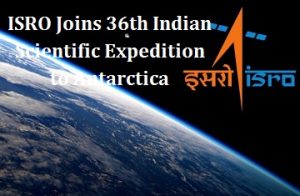The Indian Space Research Organization (ISRO) officially declared that it has launched four teams to the 36th scientific mission to Antarctica on March 22, 2017. The mission has been organized by The National Centre for Antarctic and Ocean Research (NCAOR), Ministry of Earth Sciences and Government of India.
- Climatic change is the main area of focus in this Expedition.
The four teams that went to Antarctica are as follows,
- Space Applications Centre (SAC) Ahmadabad with two members
- National Remote Sensing Centre (NRSC) Hyderabad with four researchers
- Indian Institute of Remote Sensing (IIRS) Dehradun with one scientist and
- Space Physics Laboratory(SPL) VSSC Thiruvananthapuram with three members
History
- The first ever Indian Expedition to Antarctica is carried out on 1981-1982 by Dr. Sayed Zahoor Qasim and team.
- India has three research stations in Antarctica namely Dakshin Gangotri, Maitri and Bharati.
Objective
The main objective of this expedition is to install stakes on ice for Differential Global Positioning System (DGPS) measurements around Bharati and Maitri to validate glacier surface velocity derived from satellite data and to estimate thickness of snow over land and sea ice using Ground Penetrating Radars (GPR’s). In addition to that, snow over sea and land ice is to be verified.
Roles played by Space Applications Centre (SAC)
Space Applications Centre (SAC) is doing research in the area of Cryosphere under its Earth Observation Program.
- The team carried out helicopter based aerial surveys and collected data over the
 Antarctica ice-sheet, fast ice and sea ice floe.
Antarctica ice-sheet, fast ice and sea ice floe. - Bamboo stakes were installed over Polar Record glacier for measuring glacier surface ice velocity.
- GPR data of various Antarctic ice features were collected at three different frequencies of 400 MHz, 500 MHz and 1GHz. It may be noted that 500 MHz GPR was indigenously developed by SAC.
Roles played by National Remote Sensing Centre (NRSC)
- Out of four researchers from National Remote Sensing Centre (NRSC), three of them have participated in voyage, carrying out scientific observations on board ship en-routed to Antarctica on green house gases and aerosols.
- The observations included snow density, wetness and profile temperature in 26 pits dug on sheet ice.
Roles played by Indian Institute of Remote Sensing (IIRS)
The single scientist from Indian Institute of Remote Sensing (IIRS) made a study on Validation of remote sensing and model based Antarctica Ice sheet features and glacier landforms.
- Extensive field campaigns were conducted jointly with Geological Survey of India (GSI) as both studies have common objectives and study area.
Roles played by Space Physics Laboratory (SPL)
The team of three scientists from Space Physics Laboratory (SPL) conducted experiments in the areas of Polar Atmosphere and Polar Ionosphere.
- These studies are carried out by making measurements of aerosol black carbon.
- Balloon borne measurements of wind, temperature, humidity and ozone, measurement of boundary layer parameters using sonic anemometers as well as surface level measurements of various trace gases.



 Antarctica ice-sheet, fast ice and sea ice floe.
Antarctica ice-sheet, fast ice and sea ice floe.

